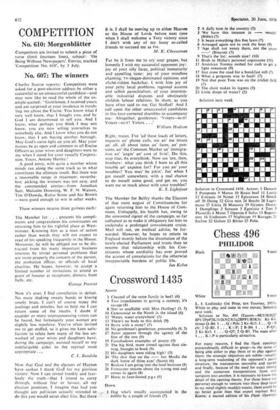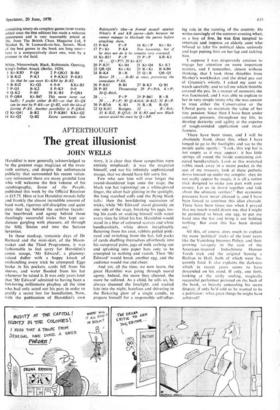Chess 496
PHILIDOR
L. I. Loshinsky (1st Prize, sass Tourney, 1953). White to play and mate in two moves; Solution next week.
Solution to No. 495 (Easom-4R3/1b3Q2I 6P1/2PpP2K/Ir2kN2/8/1q2IIPP 1 /B3R3): Kt-K6, threat Q-B4. 1 Q x Pch; 2 Kt-Kt5. 1 Q x B ch; 2 Q-B3. 1 K xP; 2 B-B4. 1 . . . P-Q5;
2 Kt-Kt5. 1 . Q-Q7; 2 Q-B3. The mate after
1 K x P is particularly attractive.
For many reasons, I find the flank openings extraordinarily difficult to grasp—in the sense of being able either to play them or to play against them; the strategic objectives are subtle—usuallY a long-term weakening of the opponent's pa.%%il structure, the manoeuvres recondite and varied and finally, because of the need for exact timing and the numerous transpositions from one variation into another, it is necessary to know the detail of the opening theory. For those brave (or perverse) enough to venture into these deep (and to my mind slightly muddy) waters, there could be no better guide than that expert mariner Ray Keene; a second edition of his Flank Openings
containing ninety-six complete games (over twenty added since the 6rst edition) has made a welcome appearance and is very reasonably priced at 26s. from The British Chess Magazine Ltd, 9 Market St, St Leonards-on-Sea, Sussex. Most of the best games in the book are long ones— here is a comparatively short one, won by a pioneer in the field.
White, Nimzowitsch. Black, Rubinstein. Opening, King's Indian Attack (Berlin, 1928).
1 Kt-KB3 P-Q4 2 P-QKt3 B-B4
3 B-Kt2 P-K3 4 P-KKt3 P-KR3 So that he can meet Kt-KR4 by B-R2.
5 B-Kt2 Kt-Q2 6 0-0 KKt-B3 7 P-Q3 B-K2 8 P-K3 0-0 9 Q-K2 P-B3 10 K-R1 P-QR4
11 P-QR4 Kt-B4?
This move turns out badly; I prefer either B-R2—so that Kt-Q4 can be met by P-K4--or Q-B2, with the idea of forcing P-K4. Another possibility is P-QKt4.
12 Kt-Q41 B-R2 13 P-KB41 KKt-Q2 14 Kt-Q2 Q-B2 Keene comments that
Rubinstein's idea—a frontal assault against White's K and KB pawns—fails because he cannot manage to blockade the pawns before attacking them.
15 P-K4 PxP 16 KtxP KtxKt 17 P x Kt P-K4 Too loosening, but if
he does not do it he remains very cramped.
18 Kt-B3! PxP 19 PxP KR-K1 19 . . . Q xP??; 20 Kt-K51
20 P-K51 Kt-B4 21 Kt-Q4 Kt-K3 22 QR-Q1 Kt x Kt 23 B x Kt B-KB4 24 B-K4 BxB 25 QxB QR-Q1 Better 25 . B-B1 at once, preventing the immediate P-K6.
26 P-K6! B-B1 27 B-K5 Q-B1 28 P-B5 Threatening 29 PxPch, KxP; 30 Q-B4ch.
28 . . . PxP 29 P-B6! R x R - 29 . . . PXP; 30 Q-Kt6ch; B-K12; 31 BxP. 30 P-B7ch K-Rl - 31 RxR R-Ql 32 Q-Kt61 Resigns. 32 . . . R x Rch; 33 K4t2, R-Q7ch; 34 K-R3 and now Black cannot avoid the male by Q x RP.



































 Previous page
Previous page